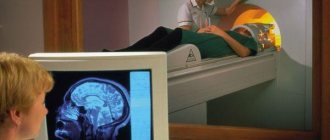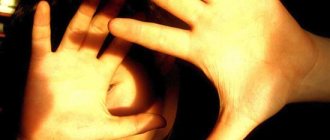Topical diagnosis of sensitivity disorders (types of disorders).
Types of Sensory Disorders
:
1) peripheral (all types of sensitivity are upset, but differ in the zone of disturbance):
n neural - with damage to the nerve trunks, i.e. sensitivity disorders coincide with the zone of innervation of the peripheral nerve;
n polyneuritic - sensitivity is impaired in the end sections of the upper and lower extremities, like “gloves” and “socks”;
n radicular - with damage to the posterior spinal roots, sensitivity disorders in the corresponding dermatomes. On the body, dermatomes are located in the form of transverse stripes, on the limbs longitudinal, on the buttock in the form of concentric semicircles;
n ganglionic - with damage to the spinal ganglion - a rash of blisters may appear in the affected dermatome - herpes zoster.
2) central
:
spinal
Attention!
If you need help writing a paper, we recommend turning to professionals. More than 70,000 authors are ready to help you right now. Free adjustments and improvements. Find out the cost of your work.
Cost calculationGuaranteesReviews
- segmental type of sensitivity disorder - with damage to the posterior horn and anterior white commissure of the spinal cord. There is a dissociated sensitivity disorder, i.e. loss of superficial and preservation of deep sensitivity in the same areas as when the roots are affected;
- conduction type - loss of sensitivity on the entire part of the body below the level of the lesion (paraanesthesia) on the same side;
cerebral (with damage to the medial lemniscus, internal capsule) - all types of sensitivity according to the hemitype on the opposite side are upset:
- thalamic - violation of all types of sensitivity according to the hemitype on the opposite side with the presence of trophic disorders and thalamic pain in the area of sensitivity disturbance;
- cortical - the hypoesthesia zone on the opposite side varies depending on the location of the lesion in the postcentral gyrus (usually monoanesthesia).
Symptom complexes of sensory disorders that occur when various parts of the sensory pathways are affected.
Damage to the peripheral nerve trunk
- disturbance of all types of sensitivity of the peripheral (mononeuritic) type.
Nerve plexus damage
- disturbance of all types of sensitivity of the peripheral type;
- motor and autonomic disorders in the innervation zone;
- pain and paresthesia.
Damage to the dorsal roots
- violation of all types of sensitivity of the segmental (radicular) type;
- acute radicular pain.
Damage to the posterior horn of the spinal cord
- sensitivity disorders of the segmental (dissociated) type;
- tendon and periosteal reflexes are lost or reduced;
- poorly localized pain is noted.
Lesion of the anterior white commissure
- bilateral and symmetric (“butterfly-type”) sensitivity disorders of the segmental (dissociated) type;
- preservation of reflexes.
Posterior funiculus lesion,
- loss of deep sensitivity of the conductive type;
- posterior columnar or sensory ataxia occurs.
Damage to the lateral cord
- disorders of pain and temperature sensitivity of the conductive type on the side opposite to the lesion;
- central paralysis on the affected side.
Transverse lesion of half of the spinal cord
(Brown-Séquard syndrome)
- central paralysis downward from the level of the lesion;
- violation of deep sensitivity on the affected side;
- impairment of surface sensitivity on the affected side according to the segmental type and on the opposite side (1-2 segments below the level of the lesion) - according to the conduction type.
Medial lemniscus lesion
- hemianesthesia of superficial sensitivity;
- sensitive hemiataxia on the opposite side to the lesion.
Thalamic lesion
- hemianesthesia of superficial sensitivity;
- sensitive hemiataxia on the opposite side to the lesion;
- hemianopsia of opposite visual fields;
- thalamic pain in the opposite half of the body.
Damage to the internal capsule
(“three hemi syndrome”)
- hemianesthesia of superficial sensitivity;
- sensitive hemiataxia on the opposite side to the lesion;
- hemianopsia of opposite visual fields;
Damage to facial sensory pathways
- if the root of the cranial nerve is damaged,
all types of sensitivity are lost (peripheral type); - damage to the sensory nucleus of the V cranial nerve
; sensitivity disorder of the segmental (dissociated) type in the segmental annular zones of Zelder.
Damage to the sensitive area of the cerebral cortex
(postcentral gyrus)
- loss of all types of sensitivity in hemi- or monotype on the opposite side;
- seizures of Jacksonian epilepsy are partial attacks of paresthesia or pain spreading in areas of the body in accordance with the sequential inclusion of centers in the postcentral gyrus (Jacksonian march).
We will help you write any paper on a similar topic.
- Essay
Topical diagnosis of sensitivity disorders (types of disorders).
From 250 rub.
- Test
Topical diagnosis of sensitivity disorders (types of disorders).
From 250 rub.
- Course work
Topical diagnosis of sensitivity disorders (types of disorders).
From 700 rub.
Receive completed work or specialist advice on your educational project
Find out the cost
Causes and manifestations
Dysesthesia often occurs when the patient is resting and their muscle mass is relaxed. It begins with incomprehensible and inexplicable sensations (tingling, discomfort, “goose bumps”), which gradually intensify. In the morning, the disease very rarely makes itself felt.
Most often it appears after 20 years of life. Every year the intensity of the sensations increases, attacks and exacerbations occur more often. Dysesthesia can be concomitant with symptoms of diseases such as:
- uremia;
- renal failure;
- neurosis;
- rheumatoid arthritis.
It can also occur in pregnant women. It is inherited, but does not pose any serious threats to life.
Characteristic symptoms:
- Increased sensitivity in nerve endings . Noticed in pathologies in the mucous membranes of the skin.
- Increased excitability of neurons of the sensory system : hippocampus, sensory areas of the cerebral cortex, nuclei of the amygdala complex, and so on. Occurs with encephalitis, neuroses and certain mental disorders.
Diagnostics
To establish the root cause of numbness in the arms and legs, you need to undergo hardware diagnostics: Doppler ultrasound of the blood vessels of the abdominal cavity, X-ray examination of the spine. Since numbness of this type in every 2 cases is associated with impaired cardiac activity and a tendency to develop a heart attack, an additional ECG is performed.
If the X-ray examination provides insufficient information, the patient is referred to undergo an MRI or CT scan. The doctor receives a significant amount of information from a survey and examination. Laboratory diagnostics takes a secondary place and helps to specify the characteristics of the identified disorders. In particular, to clarify the severity of the inflammatory process, establish the risk of developing a heart attack, and determine the level of glucose in the blood.
Providing medical care
At the first symptoms of dysesthesia, you should definitely see a doctor. The onset of the disease may be an indicator of the presence of serious problems in the body. Doctors will determine the cause and prescribe effective therapy. And to make your well-being easier, you can use the following tips:
- move a lot , taking walks before bed, since it is walking that enhances chemical reactions, freeing the brain from endorphins, promoting overall restful and sound sleep;
- If you experience discomfort in the lower extremities, you can get up and walk around the room ;
- don't overeat before bed;
- take multivitamins - according to research, the cause of this disease lies precisely in the lack of folic acid or iron;
- taking Aspirin - doctors could not explain exactly how it works, but in some patients, after taking it, their general condition improved significantly;
- avoid stressful situations;
- alcohol should not be taken as a sedative or pain reliever.
Fans of traditional methods of treatment claim that foods enriched with magnesium help improve well-being for various types of dysesthesia: soy, milk, wheat bran, almonds, nuts, pumpkin seeds.
Treatment
Sensory impairment syndrome can be eliminated immediately after eliminating the main cause that caused this condition. Therapy consists of the use of complex measures. The use of drugs is not a priority action. Medications put a strain on the function of internal organs: the risk of damage to the liver, kidneys, and heart increases. In addition, medications are addictive.
Modern therapeutic programs are designed with an emphasis on manual (manual) influence. This type of treatment has a number of advantages, the main one being the absence of harm to the immune system and the activity of internal organs. When a syndrome of impaired sensitivity of the limbs is detected, manual types of treatment are prescribed, the most effective of which are:
- Kinesio taping. A modern, proven method for eliminating problems with sensitivity in the hands and feet. It involves the use of special tapes that are applied directly to the pathological focus. On the one hand, the tapes are treated with a medicinal composition, which upon contact with human skin has a therapeutic effect. The procedure is safe for health.
- Massage. The procedure is aimed at restoring sensitivity in the limbs by improving blood circulation. Already after 1 session, the limbs feel fluctuations in the temperature of the external environment and tactile influence. In an uncomplicated case of decreased sensitivity of the hands and feet, the course is 7-10 sessions.
- Osteopathy. The procedure is aimed at restoring the physiologically correct position of the vertebrae, intervertebral discs, and joints. Thanks to the change in the localization of the anatomical segments, they stop compressing the nerves, and the sensitivity of the limbs is restored. Professional osteopathy normalizes the conductivity of nerve fibers after the first session.
- UVT. An effective method of physiotherapy, which is used as an addition to general prescriptions or as the only therapeutic effect. Shock wave therapy accelerates blood circulation, improves tissue thermoregulation, eliminates paresthesia and other unpleasant sensations. Thanks to the treatment of insensitive limbs with acoustic waves, the innervation of the arms and legs is restored.
Only the doctor determines the type of procedures required in a particular clinical case and sets the duration of the general therapeutic course. The specialist takes into account the patient’s age, his general condition, and the reason for the weakening of the innervation of the legs and arms.
Limb sensitivity syndrome is a clinical manifestation of many diseases of the musculoskeletal system, nervous and endocrine systems. No less often, the symptom is of oncological origin. In order to receive effective treatment in a timely manner and get rid of the underlying disorder that causes numbness in the arms and legs, you need to make an appointment with a doctor. Before undergoing a consultation at Dr. Dlin’s clinic, taking medications is contraindicated, since their effect distorts the clinical picture and complicates the possibility of quick diagnosis.
Sensation and perception (continued)
Quantitative perception disorders
Quantitative perception disorders include its increase, decrease, or absence.
Increased perception includes so-called sensory hyperpathies
(Latin “senso” - feeling, perception; Greek “hyper” - above, “pathos” - disease, deviation).
A group of disorders in which perception is reduced is called sensory
(Latin “senso” - feeling, perception; Greek “hypo” - decrease, “pathos” - disease, deviation).
In addition to the disorders discussed in the previous section, associated with the loss of sensations and leading to the impossibility of perception, agnosia
(Greek agnosia: “a” - without, not; “gnosis” - knowledge).
Sensory hyperpathies
are characterized by a sharp increase in perception, in which all images of the external world become irritatingly bright, sharp, and distinct. Sensory hyperpathies are based on various hyperesthesias. The threshold of perception in such patients is lowered, the time of perception of irritation is prolonged. Subjectively, hyperpathies are difficult for patients to tolerate. They try to alleviate their condition by artificially reducing the flow of irritants to the receptors: they ask to speak more quietly, turn off the radio and TV, plug their ears, close their eyes or turn off the lights, pinch their nose, try to breathe only through their mouths, wear clothes only made of soft fabrics, turning them with seams outward. , “so that they do not irritate the skin.”
Most often, sensory hyperpathy, like hyperesthesia, occurs with intoxication, organic brain damage, with the hyperergic stage of asthenia, with eclampsia in pregnant women, with angry mania, and ecstatic states.
In children and adolescents, sensory hyperpathies are observed during infectious delirium, as well as during intoxication with certain inhalants or drugs. Sometimes the purpose of using an inhalant is to obtain a feeling of special brightness of colors and heightened hearing. This happens, for example, when inhaling toluene vapors or nitro paint solvents. A similar effect is observed when using many psychedelic drugs (Greek “psyche” - soul, “delos” - enlightenment), ephedrine: the music becomes unusually loud, the colors become saturated, and synesthesia occurs. It should be noted that in a state of drug intoxication, along with a pathologically elevated mood (euphoria), sensory hyperpathies are accompanied by characteristic negative emotions (anxiety, fear).
If children and adolescents who take drugs have residual organic brain disorders, intoxication often takes on an atypical character and can also recur after a short time without using the drug. In this case, one of the significant symptoms is often sensory hyperpathy.
Sensory hyperpathy may occur at the onset of schizophrenia. Here is what sick Andrei K., 17 years old, said about his experiences: “Everything is as if on the set where a movie is being filmed, it is flooded with bright electric light. All sounds are fed through an amplifier, there is no hiding from them. The shadows became black, and the objects that cast them became sinister.” The experience of sensory hyperpathy in such cases often receives a delusional interpretation.
Sensory hypopathy
is the opposite of sensory hyperpathy and is characterized by a decrease in the brightness and clarity of perception of objects and phenomena of the surrounding reality without violating their identification. The threshold of sensations is increased. Patients are usually, but not always, critical of these disorders.
There are three types of sensory hypopathies:
1. Allopsychic
(Greek “alios” - different, other, “psyche” - soul)
depersonalization
(Latin “de” - prefix meaning change; “persona” - personality).
2. Somatopsychic (Greek “soma, somatos” - body) depersonalization
3. Autopsychic (Greek “autos” - oneself) depersonalization. Allopsychic depersonalization -
This is a decrease in perception of the surrounding world.
The perception of color, sound, space, time, and tactile stimuli is difficult. At the same time, patients complain that sounds are muffled, tactile sensations are unclear, perspective is lost, colors fade, everything around becomes dull. Such changes in perception are difficult to experience and give patients the impression of the unreality of the environment. In connection with this, a synonym for allopsychic depersonalization is the term derealization
(Latin “de” is a prefix meaning change; “realis” is real).
When talking about their condition, patients often use metaphors: “I see everything as if through a cloudy inferno,” “sounds like cotton wool.”









